Hubsan
Hubsan FPV X4 Plus (H107D +): a mini-drone for resourceful beginners
Aprox. 72€ - see price -
See specificationsAmong the models of the H107 series from the Chinese manufacturer Hubsan, the H107D + - also called X4 Plus FPV - has the particularity of providing real-time video feedback to the user, allowing immersion control via the screen of its remote control. Rather intended for beginners wishing to learn the basics of piloting, it however requires a little patience to tame it. The fact is that despite its docile airs, the beast has its outbursts of anger ...
Positive points
Good responsiveness in controls and video feedback.
Radio control with LCD screen provided.
Immersion flight.
Bad points
Obligation to calibrate frequently to avoid control problems.
Brightness of the radio control screen too low.
Low image quality of video feedback.
Insufficient "Failsafe".
No hulls provided for indoor flight.
Proprietary battery and weak autonomy.
Our review
Presentation
There are many quadcopters in the Hubsan catalog. The manufacturer indeed offers all kinds of models and a large quantity of mini / nano-drones which are only intended to amuse their owners and make them discover piloting, even racing and immersion flight. The X4 Plus FPV is one of the most advanced in the latter category, with its small integrated HD camera and its LCD remote control which promises an interesting experience.
The X4 Plus FPV (H107D +) of this test was loaned to us by StudioSport, which we thank in passing.
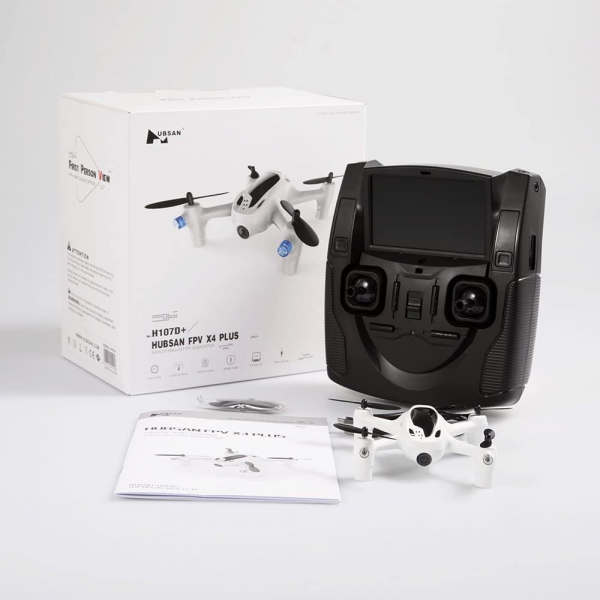
Getting started
With its matt white hull decorated with a shiny black part reminiscent of a windshield, the X4 FPV Plus has the air of an airplane of the future. This sleek design is associated with a neat construction, the device being entirely faired; no wire or piece of circuit sticks out. The finishes are not exceptional, but the device inspires confidence and seems quite robust.
On the other hand, we regret at the outset that optional propeller protections are not provided, for indoor flight in particular. Indeed, although the 52 mm diameter propellers fit well on the axes of the engines, they can damage the furniture in the event of an impact and be damaged at the same time. Fortunately, their replacement is very simple and you can always find compatible hulls at certain retailers for a few euros with spare propellers.
The drone is equipped with two blue LEDs at the front and two red LEDs at the rear to better identify its orientation in visual flight. These flashes when there is only 30 seconds of autonomy left.
No connection with a smartphone here, the drone is controlled with a radio control in radio link 2.4 GHz. The one supplied with the H107D + is fairly classic and the rigid plastic of which it is made is quite low-end. This is hardly surprising for a drone sold for just over a hundred euros "only". We will not complain about that, because despite its basic construction, this remote control incorporates a 4.3 "(10.9 cm) LCD screen. The latter lacks a bit of brightness and its TN technology is synonymous with fairly low viewing angles (the vertical angle in particular), but its inclination somewhat compensates for this latter defect, again difficult to be too demanding at such a price level.
The screen is in any case very practical for piloting by directly observing what the drone sees through its camera, thanks to an analog video link in 5.8 GHz. The image quality is certainly poor quality with its definition of only 640 x 480 px, but allows a fairly low latency, much more important for driving than a good definition.
Regarding the pairing, nothing complicated, just turn on the radio control, then the drone which will then be placed on the ground. The connection is then made automatically and the image captured by the camera is displayed on the screen. All that remains is to arm the motors by wedging the sticks in the lower outer corners, or simply pushing up the one associated with the gases so that the aircraft takes off ... at least when everything is going well and the calibration has been done well - we will come back to this in the flight section.
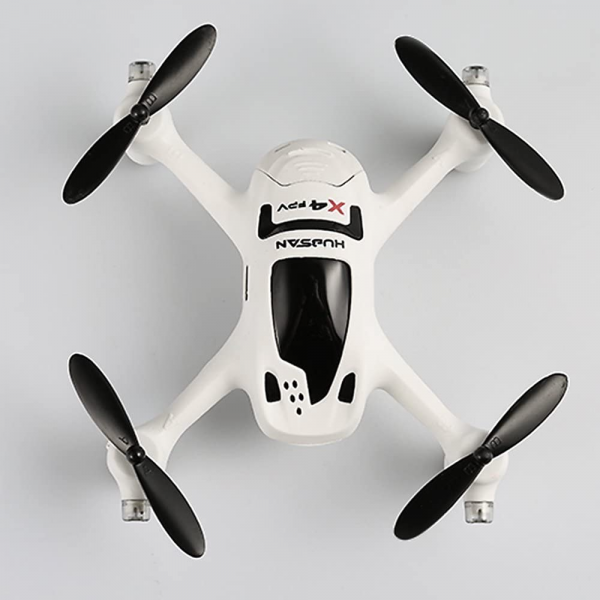
Flight
The H107D + incorporates small brushless brushes Coreless CL-0820 which ensure good liveliness. The device is quite responsive and we can start having fun when we manage to control it ... provided it lets us do it and we get used to its particular driving mode! Indeed, it is first necessary to ensure that it is roughly stable, which involves balancing using the "trim" buttons of the radio control: drone placed on a flat surface, it is necessary press each of the 4 trims in one direction and then the other until you hear a long beep. Neglecting this step is often synonymous with more or less pronounced drift of the drone, which can no longer be corrected once in flight - according to our tests. We also also happened to see joysticks inoperative in certain directions, implying a recalibration of these. Nothing very complicated, but the drone tends to go wrong and the operation becomes tedious when it must be repeated before a flight. More annoying, it was several times impossible for us to stop the motors from the radio control, which can become dangerous in certain situations.
After these annoyances which can notably put off a certain number of beginners, we discover a particular mode of control, precisely designed for novice pilots. The X4 FPV Plus is indeed stabilized in height and the joysticks of the radio control both have a return to the automatic center. In other words, whatever the control mode chosen, you can switch from mode 1 to mode 2 or even 3 when the radio remote control is switched on - the throttle always returns to the center and does not actually control the gases, but the height of the drone. A push upwards and the drone rises until the stick returns to the center, to then stabilize in height. If this behavior is reassuring enough for beginners, it can destabilize pilots who are a little more knowledgeable, accustomed to controlling the gases from their aircraft directly. This way of controlling the height of the drone also requires a certain flexibility to avoid too sudden changes in height, when it suffices to give a little blow or release the gas a little with a more conventional drone. If this H107D + was stable enough, it would not really be a problem, but it is not always the case and we have happened several times to have to correct the height when the drone should have stayed there alone.
The solution for a little more control? Switching to "Expert" mode, which removes the smoothing of commands and thus makes the drone more lively, the slightest movement of stick being taken into account. The sensitivity is adjustable for the normal mode as for the expert mode in the menu of the radio control. However, that does not change the general behavior of the drone, which remains - more or less - stabilized in height. No "acro" mode either, the only possible aerial figures are those prerecorded and accessible via the "Flip" mode which is activated by prolonged pressure on the stick associated with the gases.
Hubsan announces up to 100 m range with its radio control. In fact, we frankly advise against playing with the limits and we have lost the signal several times outdoors at a much shorter distance, especially when the drone takes off. Problem, if the signal is lost, the motors do not shut down (no real "failsafe"). The drone is content to not move and can very easily drift with the wind! Suffice to say that the risk of losing it is significant, not to mention the danger that an uncontrollable device - however small it may be - could fall on a passerby. As a precaution, if the signal becomes too bad and you no longer know which way the drone is, you can engage the "headless" mode, with which the position of the drone no longer matters. Indeed, if we push the stick, the drone leaves in front of us, if we orient it to the left, it goes to our left, and vice versa. Convenient to make it come back to us in visual flight. Conversely, this mode is obviously unusable in immersive flight.
The drone can transmit its video signal at frequencies between 5,730 and 5,845 MHz (adjustable in steps of 5 MHz), which makes it compatible with certain immersion glasses.
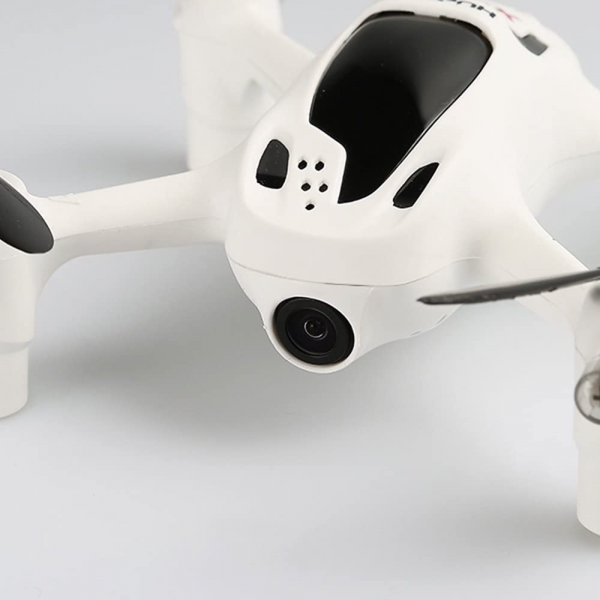
Image quality and video feedback
The camera of the X4 FPV Plus is mainly designed to provide real-time video feedback to the pilot. Responsiveness prevails under these conditions. Satisfactory, it offers good control and allows rapid changes of direction. The camera is not too oriented towards the ground, which allows you to continue to see a little in front of the drone when it flies quickly.
The drone can record photos in 1600 x 1200 px and videos in 1280 x 720 px on a microSD card, but the image quality frankly leaves too much to be desired to obtain an exploitable result. Even a recent entry-level smartphone would do better. The recording is therefore mainly used to keep some memories of theft.
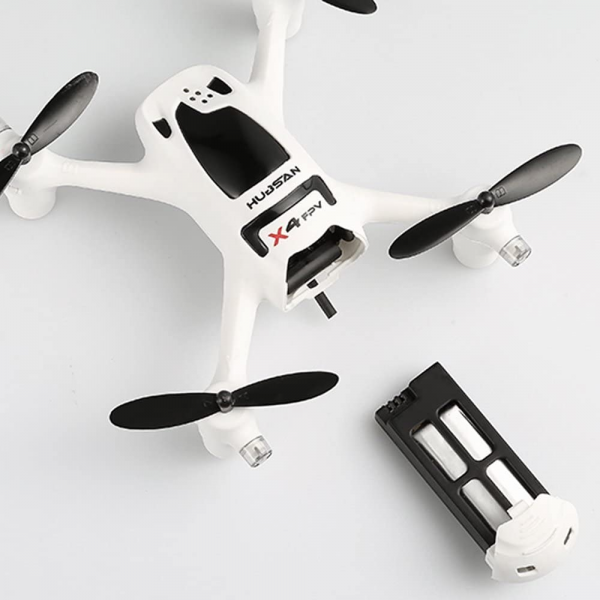
Autonomy
Housed in the body of the drone, the LiPo 1S 3.7 V 520 mAh battery is unfortunately in a proprietary format. We certainly gain in terms of finish and practicality to insert it into the drone - a connector is simply at the bottom of the housing (no need to connect it by hand and no visible wire) -, but it will be necessary to buy specific batteries and therefore not reusable in the event of a change of aircraft or for flying with another drone. This also means recharging it via the drone, since it cannot be connected to a universal charger without having to use an adapter.
Charging is easy, since you only need to connect a charger to the micro-USB port on the X4 FPV Plus. However, it still takes more than an hour, which is long and inconvenient when you need to recharge several batteries. Especially since removing the battery requires a certain amount of skill - which does not, however, prevent it from leaving its housing alone during certain crashes.
Allow about 7 minutes of hovering with the X4 FPV Plus, and of course a little less if it is used a lot. A low battery alert occurs 30 seconds before the engines are shut down, a sign that you must land quickly or risk falling.
On the side of the radio control, you have to do with 4 AA batteries that you have to change often enough (about 1h30 of autonomy), it is quite energy-consuming because of its screen. No possibility of using a battery, despite a mini-USB port on the side which could have been used for recharging - or for connection to a computer. Like the microSD card slot next door, this port is ultimately useless with the X4 FPV Plus.
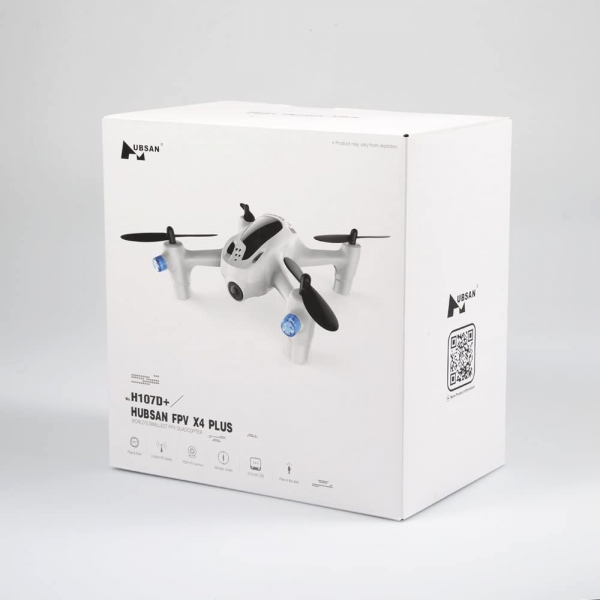
Conclusion
If it seems simple to use, the X4 FPV Plus cannot be tamed so easily, requiring regular recalibration. The stability of the flight can thus become a little precarious. It is all the more unfortunate that once properly adjusted, this Hubsan mini-drone is rather pleasant to fly.
Specifications
Reviews

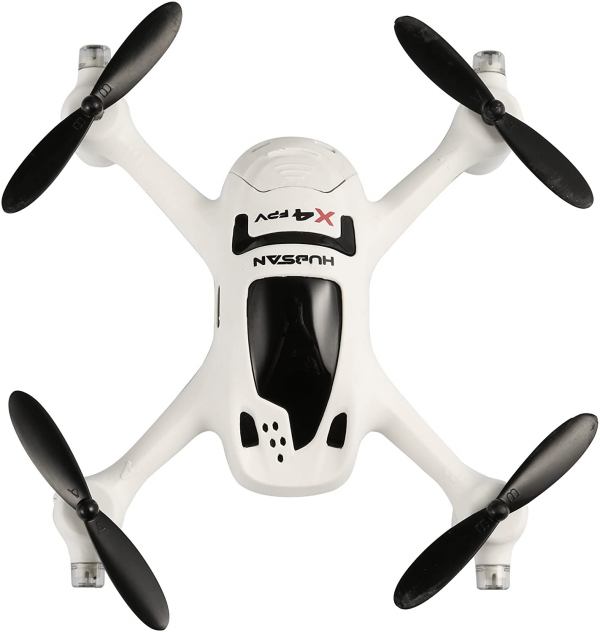
Great little quadcopter. Fun and easy to fly.
I really like this little quadcopter. I have flown it quite a bit and have not had a single issue with it. Yes, the transmitter does chew up batteries, but that is to be expected with a built-in video screen. You can do a lipo battery mod to the transmitter, but I just bought rechargeable AA batteries and they work great. I can go through 5 quad batteries before I need to charge my AA's for the transmitter. I purchased extra batteries and a carrying case on Amazon. The altitude hold in my opinion works exactly as it should, it does require some getting used to if flying indoors with low ceilings. Some people commented about the wind blowing it away, well I flew it in 10 MPH winds the other day and I had no problems controlling it at all. Sure it will blow away if you don't know how to fly it, so will any quadcopter that doesn't have GPS on it. The photo and video quality is pretty impressive for this little quad. I like the FPV so I can actually see what the camera is looking at when I'm taking photos and videos. I do have a DJI Phantom 3 and Yuneec Q500 + that I use quite a bit, but I still fly this H107D + all the time, it's a lot fun and easy to fly. I would recommend this to anyone that wants a good little FPV quadcopter. I purchased mine on Amazon and received it very quickly from HeliDirect.
Cool FPV micro quad!
The first one showed up broken. Amazon was very quick to replace it. The quad flies great: it is fast and stable. It is a bit fast for close quarters. The picture quality is surprisingly good. This is good for transitioning from beginner quads to intermediate quads and getting started with FPV.
My very first quadcopter experience.
Update 9/2/2016
2nd one - exhibits same issue - altitude hold feature is faulty and you have to constantly fight the copter from wanting to fly up and away. The problems with this toy are well documented throughout the web. Caveat Emptor
Update 8/23/2016
Don't buy this particular product / model. I wanted to love it, but after 2 fly-aways never having gone above 10ft - lost it after the second in a light breeze. Batteries full - less than 2 minute flight. Throttle didn't respond = money wasted.
Original Review:
Long story short: If I had to do it all over again, I'd get one with GPS and RTH.
Long Story:
I've been an RC enthusiast (mostly cars and boats) for at least 30 years, but never flew anything outside of a Brookstone. Prior to my order, I did my homework - studied-up on everything I could get on the H107D + in order to make a somewhat intelligent purchase.
First impression: I couldn't stop grinning because it's so tiny and looks wicked cool. Charged up the battery and installed batteries in the TX - turned it on - binded (bound?) - and a live image showed up on the display. Took it outside and immediately started to fly, albeit really low and slow. I shot some video off the unit and it was very sharp (unlike many of the reviews) great image stabilization. At this point I'm not ready for FPV flying yet - plus the image on the transmitter is useless in the bright florida sun ...
Charged all the batteries - went to a huge open park across from where I live. Found a level post that I could fly this thing off. (Note: It is so little that blades of grass keep the props from spinning. You need a semi-smooth, level surface to take off and land.)
Started flying and capturing video. I kept it within 20 ft off the ground and kept familiarizing myself with it. There was a light breeze and very sunny. The response in Normal mode felt rubbery and unresponsive. I did take it a little higher and it started drifting. No amount of trimming would make a difference. It started taking altitude and flying away! Running after it, I kept trying to shut the motors down just like the manual said. The quad flew about 300 yards, crossing over an avenue, almost swiping a power line pole until I lost sight of it. TOTAL FLIGHT TIME: 3 Minutes!
After lots of triangulation and sweating in Florida's 92 degree weather, I found the little bugger in a bush, in the general vicinity that I hoped it was in. No damage to the H107D + but the video was not saved. Seems to happen quite a bit - I'll end up with 8 video files, but only 2 of them contain actual video. Flight time is about 4-6 minutes max.
I got home - recharged batteries - and took it outside again to see what's up with the drifting issue. I put it into Expert mode and it became a different creature - responsive and tight - A much more rewarding flight and in my opinion, much easier to fly. Calibrated the gyro and controller. Again, the drifting is a bit of an issue and very wind-dependant. Props are fine and nothing is binding, causing the issue.
Day 1 - I've crashed it several times now and I'm still on the original props. The little guy is a lot of fun and this is said to you from my limited experience.
I bought extra batteries and props for the copter. I also bought the antenna modification kit for the controller and I'll be performing the Li-po battery mod to it also. Hopefully, I'll see a difference.
The good:
Tiny - No FAA issues
Fun toy
Spare parts available
The Bad:
No prop guard
Proprietary batteries and chargers
No Return Home
No GPS
4-6 minute flight time
Flyways
Drifts
Requires upgrades
In Conclusion: Not bad - could be better. You need to ask yourself what is your objective? This drone will help you learn FPV flying and will take consumer-grade video and photos. If you are serious about either, fpv racing or real video, this is not the one. Even though I'm enjoying this little quad, I would not buy another one - I'd spend a little more and get a brushless motor quadcopter with FPV, GPS and RTH functions. Too much money to just throw away on something that has non-pilot-error-related issues.
it works good but the Fpv camera range is not very far
It is more of a beginner level fpv quadcopter, it works good but the Fpv camera range is not very far. It is a-little disappointing to me but Hubsan makes some very good products, this one is not for me. I have other Hubsan drones that I really like!
I've try just about every drone including the well known DJI drones and this drone is almost as good as a DJI
This drone is a beauty. I've try just about every drone including the well known DJI drones and this drone is almost as good as a DJI. I usually don't bother with ratings but with how low the rating on this drone.